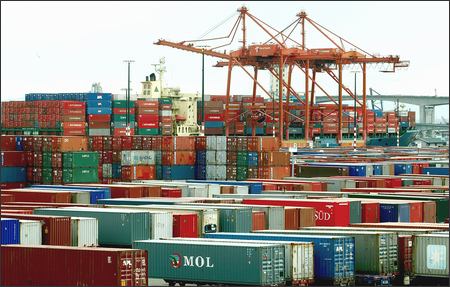forum
library
tutorial
contact

Transportation Officials
Seek Solution to Bottlenecks on Rails
by Brad Wong, P-I reporter
Seattle Post-Intelligencer - April 8, 2005
|
the film forum library tutorial contact |

|
Transportation Officialsby Brad Wong, P-I reporter
|
 Puget Sound-area port officials often boast that they can handle the goods arriving to meet an insatiable nationwide demand for inexpensive Asian imports.
Puget Sound-area port officials often boast that they can handle the goods arriving to meet an insatiable nationwide demand for inexpensive Asian imports.
In the region's transportation network, though, the bottleneck in the coming years likely won't be the ports, but the train system.
Trains hauling international cargo and other goods from the Puget Sound area over Stevens Pass will encounter congestion by 2009, according to a report conducted for the Washington Public Ports Association.
The reason: Stevens Pass, one of the main and direct rail lines to the major inland market of Chicago, has a sustainable capacity of 28 trains per day. But by 2009, especially near the winter holiday season, those tracks could see a peak of 34 trains daily.
"This is not a simple fix," said David Hatzenbuhler, MainLine Management Inc. president and the author of the report. Using import projections of sea cargo, he estimates that Stevens Pass could see about 50 daily trains by 2025.
A second track and other major rail improvements to the pass are unlikely because of that area's steep topography. Improvements, his report said, could cost $500 million.
Higher demand could divert trains to routes along the Columbia River, a flatter area. But on that route, which also can be crowded, it can take longer to bring time-sensitive goods to market.
With more imports in mind, BNSF Railway Co., one of the main freight haulers in Washington, is considering improving Stampede Pass, the third major rail route across the state.
The pass cannot accommodate international cargo, which travels double-stacked on train beds and can stand more than 20 feet high. MainLine Management estimates that adding about 3 feet of space through the pass tunnel, either by lowering the tracks or notching its ceiling, will cost $25 million.
"We are looking at the possibility of modifying the Stampede Pass tunnel to accommodate international cargo containers," company spokesman Gus Melonas said.
BNSF, the state Transportation Department, shippers and the ports of Seattle and Tacoma have yet to identify specific improvements necessary or the source of funds they would need.
"That has yet to be determined. We're in uncharted territory," said Barbara Ivanov, freight strategy director for the Transportation Department.
Hatzenbuhler believes that tens of millions of dollars, if not hundreds of millions, worth of railroad improvements are needed statewide to avoid gridlock associated with increased rail demand.
"Millions won't get this job done in the short term," he said. "The railroads alone cannot fund this. We're not just talking about international trade. The railroads are in a much bigger business than that."
Garbage, passengers, boxcars, automobiles and grain, in addition to international cargo trains, make their way throughout the state by rail.
Historically, railroads have paid for their own infrastructure improvements. But given the scope of rail upgrades necessary, Melonas said, his company wants to talk with the state government and the ports about a partnership in funding.
The ports association released the rail capacity study last year, months before delays at Southern California ports got national attention and pushed more cargo ships to the Puget Sound area. This year, the report is taking on greater significance because of the increase in port traffic.
The ports of Seattle and Tacoma report that at least 60 percent of all the international cargo that goes through their facilities is destined for major inland markets. Last year, according to the Port of Tacoma, nearly $17 billion worth of imported goods moved on long-distance rail to other markets.
If the anticipated rail problems are not fixed, "The cargo could go elsewhere," Port of Seattle Commissioner Patricia Davis said.
The port's cargo director, Michael Burke, believes that public policy officials still have time to find solutions to any possible rail congestion. "This is not a crisis," he said. "But we are very concerned to make sure the rails can work."
learn more on topics covered in the film
see the video
read the script
learn the songs
discussion forum
